Cat Writers’ Association recently celebrated its 25th Anniversary Conference in St. Louis with a number of outstanding educational speakers. Emerald Level Sponsor Purina opened the sessions with a tag-team offering from Dr. Kurt Venator and Dr. Janet Jackson. The topic, of course, was feline nutrition including the benefits of wet cat food.
Purina has supported the CWA vision since the birth of our organization in 1992, offering a variety of sponsorships over the years. Having cat-centric researchers and scientists share their expertise at our historic event offered those in attendance a unique opportunity to ask questions and learn innovative ways to keep our cat companions happy and healthy.
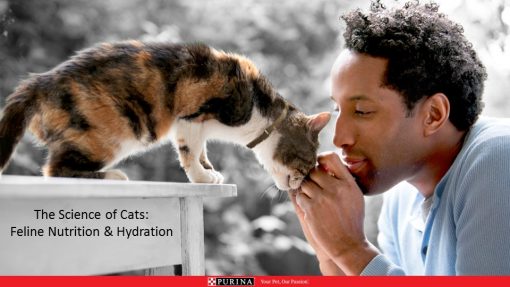
This post is sponsored by Purina™. The Cat Writer’s Association received conference support for helping spread the word about The Science of Cats: Feline Nutrition & Hydration panel information, presented at the CWA 25th Anniversary Conference, but CWA only shares information relevant to our audience. Purina is not responsible for the content of this article.
Your Pet, Our Passion
Purina’s name reflects the founder William H. Danforth’s personal belief system that remains the foundation of the company today. He chose “Purina” to emphasize the purity of the products. Danforth believed one needed a balance between Physical, Mental, Social, and Religious aspects in life to be healthy, and applied those principles in his company.
Purina speakers Dr. Kurt Venator and Dr. Janet Jackson took turns sharing information about the company, nutritional philosophy, cat-specific needs, and the power of wet cat food. The audience included dozens of savvy pet parents as well as veterinarians and behavior experts, and a lively discussion with Q & A covered much ground.
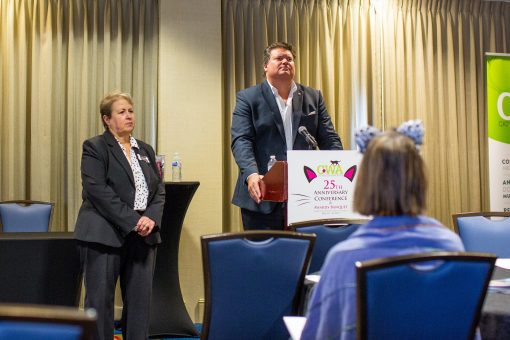
DR. KURT VENATOR has worked with Purina for 15 years and currently serves as the company’s Chief Veterinary Officer. His memories of Acadia, an irreverent and overly-intelligent yellow Labrador Retriever, continue to fuel his life-long passion for all creatures great and small. Today he shares his life with two Labradors and gets his “cat fix” from visiting his mother-in-law’s cat.
DR. JANET JACKSON has been with Purina since 1990 and is the company’s Vice President and Director of Research. She discovered her love of pets as a child, and her dogs and cats have helped shape her into the person she is today. Currently she cares for five cats.
Learn more about Dr. Venator and Dr. Jackson here.
Founding Principles Help Pets & People
Dr. Venator explained that Purina was founded on four tenets: Integrity, Passion, Expertise, and Performance. More recently, Purina added a fifth principle: Innovation. Today, the company embraces three ideals designed to push pet care forward: (1) pets are our passion, (2) safety is our promise, and (3) innovation is our pledge.
Purina employs more than 7,700 people, including 500 scientists worldwide. Research isn’t limited to nutrition, either. These scientists research scent and taste, how best to keep foods fresh, toxicologists to review ingredient safety, and many more.
Purina also has a team of behaviorists to better understand the physical and emotional well-being of pets and how their relationships with humans can impact their lives. Dr. Sandra Lyn is an expert in the study of feeding behavior of pets, and says eating is an emotional, nurturing event that shouldn’t be separated from nutrition.
Innovative Research & Shared Benefits
Purina’s research goes beyond what to put in your pet’s dish, and impacts cat and dog well-being in a variety of ways. In 2002, Purina reported a landmark 14-year-long Lifespan Study in Labrador Retriever dogs that showed calorie restriction increased longevity by nearly two years. Read the study here. That research prompted new feeding recommendations, said Dr. Venator, and the company changed to feeding less food, rather than more.
Dr. Jackson says rodent longevity studies initially prompted the research. But of course, cats are not rats, and they’re certainly not little dogs. Purina also launched a nine-year cat study exploring the effects of a blend of antioxidants, prebiotic fiber, and other nutrients on feline longevity. That resulted in ProPlan Prime Plus (dry or wet food) cat food designed to improve skin and digestive health, and body condition. The study showed that cats fed this new formulation were healthier, and lived up to a year longer. Read the study here.
While pets require very different nutrition than what humans need, the research for one species can offer benefits and insights into others. For example, probiotics have proven very helpful for humans. Some of these same probiotics have beneficial effects for cats and dogs. Dr. Jackson says after ten years of research, Fortiflora has become the top probiotic on the veterinary side. In fact, internal medicine specialist Dr. Mike Lappin uses this with herpesvirus cats in shelter environment to great effect.
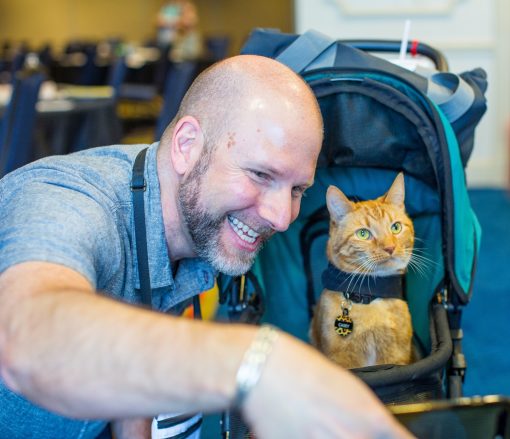
An attendee at the conference, Dr. Jason Nicholas, volunteered that he also uses Fortiflora in his veterinary practice. He says the liver digest ingredient makes it very palatable and a great motivation for these cats to eat. Here he meets CWA member Arden Moore’s kitty partner, Pet Safety Cat Casey. Image (c) 2019 Larry Johnson Photography.
A Focus on Research
Purina research and development focusses on five key areas: Healthy Early Development (kittens are different than adult cats), Healthy Metabolism, Healthy Aging, Digestive Health & Microbiome, and Oral Health. Dr. Jackson says that researchers push beyond the latest innovation to constantly ask themselves, “What can we do next? How can we gain a greater understanding to impact the health of pets?”
That starts with identifying the pet’s needs. “We have ideas,” she says, “and explore possibilities.” The pet foods Purina develops must offer a healthy benefit, but also taste great for the cat to accept and eat the food.
What About Wet Cat Food?
The audience was asked how many of us fed wet cat food, and why (or why not). Many in attendance care for cats with health issues that benefit from one form of food or another, such as kidney disease and urinary issues. Others feed a dry diet for convenience or because cats refuse other formulations. Some offer home-prepared foods, and a large showing of hands indicated a mix of different forms offered. Dr. Jackson said that surveys indicate approximately 70 percent of cat owners feed both wet and dry food.
We take water for granted, but it is an essential nutrient we all need, especially cats. Water makes up about 60 percent of the cat’s body. It maintains and regulates body temperature, aids digestion and nutrient absorption, and helps eliminate waste.
So why wet cat food? I was surprised to learn that although the average cat needs about 20 teaspoons of water per day, it takes a long time to acquire that amount. A kitty gets only 3/100 teaspoon per lap of her tongue. That’s a lot of lapping!
Canned wet cat foods can help provide water more efficiently since most wet products are 70-80 percent water. Canned diets also are closer to a cat’s natural prey, and offer higher protein content, which promotes lean body mass (LBM).
“As cats age, they naturally lose LBM and look frail, and feeding wet cat food with high protein content can help. Organs and muscles are the main source of metabolic activity,” says Dr. Jackson.
An audience member had concern about high protein for cats with kidney issues. Dr. Jackson explained older recommendations had been based on rodent studies that erroneously interpreted protein should be low to protect kidneys. “It’s actually the phosphorus levels that are more important,” she said, assuring the audience that therapeutic diets for cats with early stage kidney issues should still have adequate protein levels with reduced phosphorus.
Canned Treat Or Meal?
Cats love wet food and often are given canned as a treat, but Purina wet cat food products are complete and balanced diets can be fed as a meal. An audience member shared frustration that her cats often snubbed foods they’d previously loved. I learned a new word—that cats are neophiliacs, meaning they appreciate trying new things. The speakers suggested purchasing a “variety pack” of flavors to keep cats intrigued and fight food boredom.
…cats are neophiliacs, meaning they appreciate trying new things.
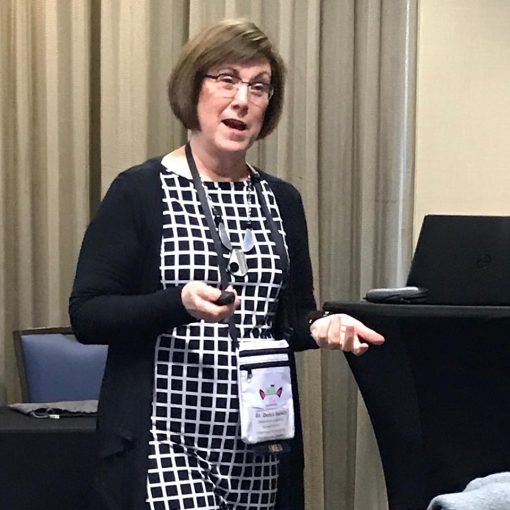
“Improving the Well-Being of Cats in the Home, Shelters, and Post-Adoption.” Image (c) Amy Shojai, CABC
This interested me, since in the “old days,” many pet food companies (and veterinarians) insisted pet parents feed one food exclusively for life. Dr. Debra Horwitz, a veterinary behaviorist in attendance, said offering a variety of foods during kittenhood helps prevent issues later in life. For instance, an old cat might refuse to eat a therapeutic diet important to their health, because he’s never eaten it and recognized it as safe. “Cats need to be taught to not be afraid of things that will prolong their life,” she said.
Feline veterinarian Dr. Jane Brunt of Catalyst Council agreed. “So much is learned in the cat’s formative years,” she said. Dr. Brunt urged attendees to ask important questions of your veterinarians. “Make sure that communication happens,” she said. Ask your veterinarian for recommendations about specific products for your kitty.
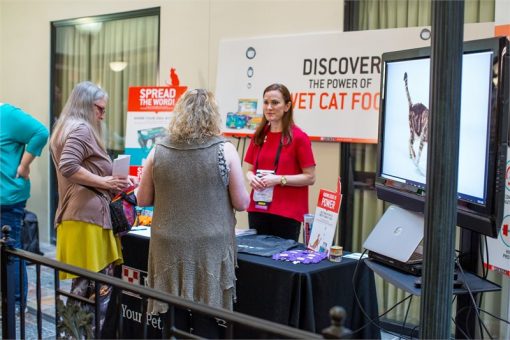
Dr. Venator and Dr. Jackson urged conference attendees to pass along information about the benefits of wet food to our various audiences (use the hashtag #purinawetcatfood). Purina provided nifty swag bag gifts to attendees: water glasses containing wet cat food coupons, and a USB with additional information (some of it shared here).
We had the opportunity to visit the Purina booth to connect with Niky Roberts, Purina Public Relations liaison. If you have ideas for how Purina can support any content you develop about wet cat food, reach out to Niky for coupons to help drive engagement.
Follow Purina at Facebook.com/Purina * instagram.com/Purina * Twitter.com/Purina * Learn more at Purina.com/WetCatFood
Your turn! Do you feed wet cat food, dry cat food, a combination of the two, or something else? (Ask your cats! *s*)
We have a 5-month old kitten which we are feeding dry food exclusively. Our previous cat would eat both eat and dry but he would only eat a small amount of wet good. Then he would not eat the remainder of the can later in the day nor the next day – chilled by the refrigerator or heated just until the chill was gone. Since we fed him the higher priced wet food, we wasted about half of the price of each can every day for 9 years. Conservatively I calculate conservatively $1.40 waste a week x 52 weeks x 8 years – $582 during his lifetime. So – it is either dry food with no waste or no cat!